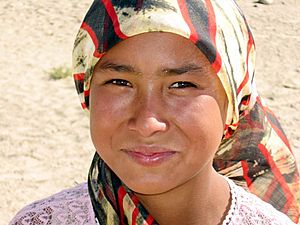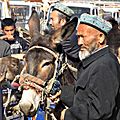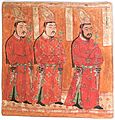Uyghur people facts for kids

Uyghur girl
|
|
| Regions with significant populations | |
|---|---|
(Xinjiang) |
11,303,355 |
| 223,100 (2009) | |
| 55,220 (2008) | |
| 49,000 (2009) | |
| 45,800 (2010) | |
| ~50,000 (2013) (Saudi Labor Ministry) | |
| ~3,500 (2015) (Uyghur Turkistan Islamic Party members plus families in Zanbaqi (الزنبقي) in Jisr al-Shughur) | |
(Uyghurs in Pakistan) |
~1,000 families (2010) |
| 3,696 (2010) | |
| 197 (2001) | |
| Languages | |
| Uyghur | |
| Religion | |
| Sunni Islam | |
| Related ethnic groups | |
| Uzbeks, other Turkic peoples and Tocharians | |
| This article contains Uyghur text. Without the correct software, you may see unjoined letters or other symbols instead of Uyghur script. |
The Uyghurs (say "wee-ger") are a group of Turkic people who mostly live in Xinjiang, China. Over 11 million Uyghurs call Xinjiang home, making it the place with the largest Uyghur population in the world. Some Uyghurs hope to have their own independent country.
Uyghurs also live in other parts of China, like Beijing and Shanghai. Many Uyghurs live outside China too. These communities are called "diaspora" communities. You can find them in countries like Turkey, Kazakhstan, Kyrgyzstan, Uzbekistan, Pakistan, and Mongolia.
Most Uyghurs follow the Muslim faith. They speak the Uyghur language, which is part of the Turkic language family. Their writing system, the Uyghur alphabet, is based on the Arabic alphabet.
Uyghurs originally came from Mongolia. They moved to Xinjiang around the 8th or 9th centuries AD. There, they mixed with the local Indo-European people who were already living in the area.
Contents
Who are the Uyghurs?
The Uyghurs are an ethnic group with a rich history and unique culture. They are one of the many different groups of people who make up China's population. Their identity is strongly linked to their Turkic heritage, their language, and their Islamic faith.
Where do Uyghurs Live?
The biggest group of Uyghurs lives in the Xinjiang Uyghur Autonomous Region in northwest China. This region is very large and has diverse landscapes, from deserts to mountains. Uyghurs have lived there for centuries.
Outside of China, many Uyghurs have moved to other countries. These communities are found across Central Asia, like in Kazakhstan and Kyrgyzstan. There are also significant Uyghur populations in Turkey and Saudi Arabia. These communities help keep Uyghur culture alive around the world.
Uyghur Language and Culture
The Uyghur language is a key part of their identity. It is a Turkic language, similar to Turkish or Uzbek. Uyghurs use a modified Arabic script to write their language.
Most Uyghurs are Sunni Muslims. Their religion plays an important role in their daily lives, traditions, and festivals. Mosques are central to their communities.
Uyghur culture is known for its vibrant music, dance, and delicious food. Traditional Uyghur dishes often include noodles, rice, and lamb. They also have unique hats called "doppa" and enjoy gatherings with music and storytelling, known as "Meshrep."
A Look at Uyghur History
The history of the Uyghurs goes back many centuries. They were originally nomadic people from the steppes of Mongolia. In the 8th and 9th centuries AD, many Uyghurs migrated to the Tarim Basin area, which is now part of Xinjiang.
Over time, they settled down and mixed with the local people. They established powerful kingdoms and empires, like the Uyghur Khaganate. This kingdom was important for trade and culture along the ancient Silk Road. Their history shows a blend of nomadic traditions and settled agricultural life.
Related pages
Images for kids
-
A Uyghur girde naan baker
-
Uyghur man in Kashgar
-
Chagatai Khanate (Moghulistan) in 1490
-
Map showing the distribution of ethnicities in Xinjiang according to census figures from 2000, the prefectures with Uyghur majorities are in blue.
-
Leaf from an Uyghur-Manichaean version of the ‘‘Arzhang’’.
See also
 In Spanish: Etnia uigur para niños
In Spanish: Etnia uigur para niños
















